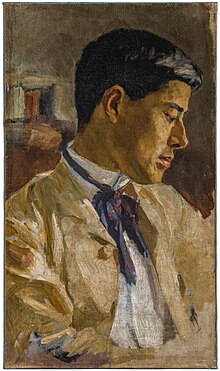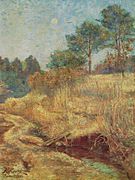Kume Keiichirō

Kume Keiichirō ( Japanese 久 米 桂一郎 ; born September 16, 1866 in Saga ; † July 29, 1934 ) was a Japanese painter of the Yōga style.
Live and act
Kume Keiichirō was born in Saga in what was then the province of Hizen . His father, Kume Kunitake , had participated in the Iwakura mission and moved with his family to Tokyo on his return in 1874. In 1881, at the second Naikoku-kangyō exhibition, Keiichirō saw pictures in the western style for the first time and was deeply impressed by it. He decided to study this painting and in 1884 took lessons from Fuji Masazō ( 藤 雅 三 ; 1853-1916). When Fuji traveled to France in 1885, he followed him a year later. Introduced by his Japanese teacher, he entered the Académie Colarossi under Raphaël Collin , where he became Kuroda Seikigot to know and appreciate. Both remained friends all their lives.
After more than seven years in France, Keiichrō returned to Japan in 1893, followed by Kuroda in the same year. The following year the two founded the Tenshin-dōjō ( 天真 道場 ) painting school , from which Okada Saburōsuke and other artists emerged. In 1896 Keiichirō and Kuroda participated in the founding of the Hakuba-kai ( 白馬 会 ) artists' association . In the first two exhibitions of this association he showed his pictures and thus became a central figure of the Impressionist style.
In 1898 Keiichirō was appointed professor at the Tōkyō bijutsu gakkō (today Tōkyō Art School ) and took part in a trip of art educators to France the following year. Around this time he turned increasingly to art education and cultural administration. He worked for the World Exhibition in St. Louis and for the World Exhibition in San Francisco, and traveled several times to the USA and Europe. He also acted for a long time as a juror for the annual exhibitions of the Ministry of Culture, Bunten .
Kume Keiichirō's descendants use a floor in the commercial building on the family property in the Meguro district for a painting gallery dedicated to him.
photos
Kiyomizu-dera , 1893
Remarks
- ↑ The Naikoku-kangyō exhibitions ( 内 国 勧 業 博 覧 会 , Naikoku kangyō hakurankai ) were exhibitions to promote the economy, which at that time also included painting.
- ↑ Colorful ( 文 展 ) is the abbreviation for Mombushō bijutsu tenrankai ( 文部省 美術展 覧 会 ).
- ↑ This picture was shown at the exhibition Japanese Painting in Western Style 1985 in the Museum for East Asian Art in Cologne.
literature
- Nihon no bijtsu No. 350 (1995): Yōga of the Meiji period - painters who went to Europe during the Meiji period. (Japanese)
- Kume bijutsukan (Ed.): Kume Keiichiro to Hakubakai no tomodachi ten. Tokyo, 1987.
- Japanese painting in the western style, 19th and 20th centuries. Exhibition at the Museum for East Asian Art, Cologne, 1985.
Web links
| personal data | |
|---|---|
| SURNAME | Kume, Keiichirō |
| ALTERNATIVE NAMES | 久 米 桂一郎 (Japanese) |
| BRIEF DESCRIPTION | Japanese painter |
| DATE OF BIRTH | September 16, 1866 |
| PLACE OF BIRTH | Saga (saga) |
| DATE OF DEATH | July 29, 1934 |
| Place of death | Tokyo |




